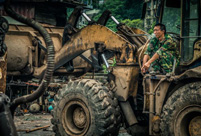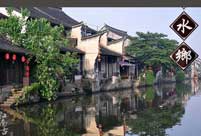 Chinese Kung Fu charms Silicon Valley
Chinese Kung Fu charms Silicon Valley
 Tranquil Yankou ancient town
Tranquil Yankou ancient town
 Lake Geneva: A show of swans
Lake Geneva: A show of swans
 Beautiful sunset over the Irtysh River
Beautiful sunset over the Irtysh River
 Qingjing Mosque: Witness of the ancient Maritime Silk Road
Qingjing Mosque: Witness of the ancient Maritime Silk Road
 Neiliansheng – more than 100 years of fashion
Neiliansheng – more than 100 years of fashion
 Golden retriever feeds baby African lions
Golden retriever feeds baby African lions
 Strange rocks in Lama Mountain
Strange rocks in Lama Mountain
 First overseas "China-standard" electric railway laid
First overseas "China-standard" electric railway laid
 College graduate launches organic agricultural cooperative in hometown
College graduate launches organic agricultural cooperative in hometownSafeguarding the bottom line: whip up the “environmental storm”
Last year, an event at the Dazi Industrial Park was both surprising and reasonable: a cosmetic firm was in urgent need to invest RMB120 million in the Dazi Industrial Park for both the policy advantages of Lhasa and the superior environment of the industrial park. Unfortunately, the company did not pass the environmental assessment. Though having had the big fish go away, the person in charge of the garden was not regrettable at all, “even the most renowned companies may have to leave as long as they possess environmental threats to Dazi and pollute the water of Lhasa.”
There are also numerous cases in Lhasa like the incident at the Dazi Industrial Park that, “does not sacrifice the ecological environment in exchange for economic gains.”
Out of both economic and environmental concerns and considering the clash between development and the environment, the Municipal Party Committee and the Municipal Government of Lhasa have reached a consensus: in Lhasa, “to build the beautiful China” is to build the “beautiful homeland and the happy Lhasa”. The distinctive ecological environment as the natural gift is the important safeguard for the sustainable development of the economic society of Lhasa. It is also one of the bottom lines that need to be safeguarded all the time.
The stronger the “environmental torrent” is, the clearer the direction gets.
--- The Pollution Charges Regulation further specifies the registration, assessment and pollution evaluation of the municipal pollution reporting mechanism. An overall pollution charges system will be implemented in order to charge 337 pollutant discharging units, which will provide RMB4.12 million of pollution funds.
--- The special inspection of the air pollution control projects will be implemented in Lhasa. 71 enterprises (units), including four industrial enterprises, eight construction sites, 15 workshops, and 44 catering service units, will be inspected. Among the units, one enterprise halted its production temporarily in order to go through rectification due to over-discharged pollution. Besides, one workshop is entirely shut down and six restaurants were ordered to install fume purification devices.
--- The monitor of automotive emission will be continued. This year, 32,528 vehicles in Lhasa will go through the inspection, of which 21,320 ones will get the green qualification certificates and 11,208 ones will receive the yellow qualification certificates.
--- Professional inspection for the quarry and sand excavation industry will be carried out among 24 units, including 21 stone pits and three stopes. Key inspection efforts have been made on 12 stone pits which were ordered to be closed in the Chengguan District. Such forceful law enforcement efforts have ensured the concerned stone pits in Chengguan District were duly shut down as required..
Besides strengthening traditional methods, technologies were also adopted as a highlight to facilitate the environmental monitor process in Lhasa.
“This is the live video monitor of the tailings of the copper mine in Nimu County, once the amount of heavy metal emission like copper exceeds the standard or the management facilities malfunctions, the monitor system will set off the automatic alarm and send text messages to the environmental law enforcement officers at the municipal environmental protection bureau, which greatly improves our environmental monitor ability and emergency capability in terms of pollution.” according to Li Weisheng, chairman of the Lhasa Environmental Bureau who proudly introduced the mechanism before the screen of the online monitor system for pollutant sources from key industrial and enterprises in Lhasa.
As the first long distance automatic monitor platform for pollutant sources in Tibet, the project of the platform under the first phase included six key water sources, one automotive comprehensive detection center, and eight industries and enterprises under the national key pollution control scheme into its monitoring scope. The practice has made the 24-hour monitor of pollutant sources available…meanwhile, Lhasa has also started its ban on “white pollution” in its scenic resorts and main traffic arteries.
The series of initiatives have made Lhasa charming and charismatic. Statistics show that during recent years, the quality standards of drinking water from the main rivers and lakes of Lhasa have been above the national III and II standards, with the water quality rate reaching 100%; the National Air Quality Test Report, released by the National Environment Protection Bureau on November 28, also shows that the rating of air quality in Lhasa is 8, with the PM 2.5 being 6 and the air quality rated as “excellent”, for which Lhasa ranks the highest on the air quality list among other Chinese cities. With the bless of the azure sky, the green lands and the clear water, the registered capital of the non-public sector in Lhasa has increased fourfold compared with that of 2011 at the same time, whereas the tax income of the non-public sector has taken 94% of the entire tax income of the city. During their first inspection trip to Lhasa, entrepreneurs of private enterprises succeeded in signing 33 project contracts with an overall investment of RMB27.69 billion in Lhasa.
 |  |
 Opening ceremony of 67th Cannes Film Festival
Opening ceremony of 67th Cannes Film Festival Pulse of Xiamen - Int'l Yoga art festival in May
Pulse of Xiamen - Int'l Yoga art festival in May Photo story: Life of a scrap metal recycle worker
Photo story: Life of a scrap metal recycle worker Training of the PLA's first female honor guard
Training of the PLA's first female honor guard China's 10 must-see animations
China's 10 must-see animations Female bodybuilders show their beauty of fitness
Female bodybuilders show their beauty of fitness A taste of Harbin cuisine
A taste of Harbin cuisine A bite of Jiang Nan
A bite of Jiang Nan Who is China's campus beauty queen?
Who is China's campus beauty queen? 8 great movies to watch with your mom
8 great movies to watch with your mom China's most luminous celebrities
China's most luminous celebrities Newly recruited police in Hetian hold drill
Newly recruited police in Hetian hold drill  Bird-men compete flying in Hong Kong
Bird-men compete flying in Hong Kong  The 'Chinese Dad'
The 'Chinese Dad' Shanghai locals bid farewell to childhood memories
Shanghai locals bid farewell to childhood memoriesDay|Week|Month